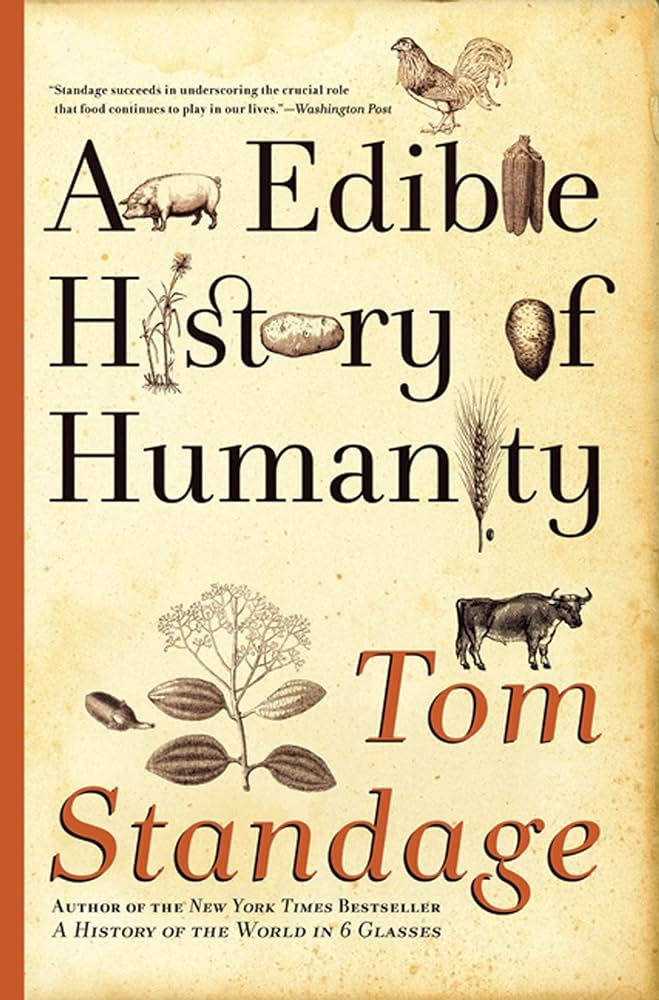An Edible History Of Humanity New World New Foods
An Edible History of Humanity New World New Foods is a fascinating look at the history of food and the ways it has shaped the world. Written by Tom Standage, the book examines the history of food, from its origins in the wild and early farming to the modern day. It looks at the impact of food on the formation of modern societies, the development of new technologies, and the global economy. It also examines the changing role of food in the modern world, from the way it is produced and consumed to the way it is used and shared. By looking at the history of food, the book provides a unique perspective on the history of humanity and its relationship with food.
The Pre-Columbian Americas
When we talk about the pre-Columbian Americas, we think about the incredible variety of foods that were cultivated by indigenous peoples in North and South America before the arrival of Columbus. These foods shaped the way we eat today and have a rich and unique history. Corn, potatoes, squash, and beans were among the most important crops for the natives of the Americas.
Corn was a staple crop of the pre-Columbian Americas and is still widely used today. It was first domesticated in Mexico and was the primary crop grown by the Aztecs and Mayans. Potatoes were first cultivated in the Andes Mountains and became a popular food source for the Incas. Squash and beans were also widely grown and used in the pre-Columbian Americas.
The pre-Columbian Americas also had a rich culinary tradition. Dishes like taco, tamale, and chili were all invented by the natives of the Americas and have become popular throughout the world. In addition, a variety of nuts, fruits, and spices were used to create a diverse range of flavors.
The pre-Columbian Americas are an important part of edible history. The variety of crops grown and the culinary traditions developed by the indigenous peoples of the Americas have left a lasting impact on the world of food. Today, many dishes are still made with the same ingredients and methods used by the native peoples of the Americas.
The Arrival of Europeans
to the Americas
The arrival of Europeans to the Americas marked an epochal moment in the history of humanity. The Old World and the New World were brought together in a way never seen before, and with this contact, new foods were introduced to the Americas. The Europeans brought with them many of the ingredients and dishes familiar to them, as well as new crops and animals never seen before in the Americas.
The introduction of wheat, barley, oats, and rye led to the widespread cultivation of breads, pastries, and other grain-based dishes. Beef, pork, chicken, and other meats were popularized in the Americas, and new techniques for raising and preparing these meats were also introduced. Dairy products such as cheese and butter also became commonplace.
Fruits and vegetables, especially those from the Mediterranean region, were also introduced to the Americas. Olives, oranges, apples, and bananas, all became commonplace in the Americas. The introduction of these new foods not only changed the way people ate, but also led to the development of new cuisines unique to the Americas.
The introduction of these new foods led to a culinary revolution in the Americas, with many of the dishes and ingredients that we now consider staples of American cuisine being introduced for the first time. As a result of this culinary revolution, the Americas developed a distinct cuisine of its own, unique from the Old World. The introduction of new foods to the Americas marked an important milestone in the history of humanity.
Transatlantic Trade and the Spread of New Foods
The Transatlantic Slave Trade of the 16th to 19th centuries marked a pivotal moment in human history. It changed the foodscape of the world forever, introducing new foods to new places and creating cuisines that would become iconic. It may seem hard to imagine now, but the foods we eat today—from sugarcane to tomatoes—are the result of this transformative period of history.
The Transatlantic Slave Trade brought with it the introduction of foods from the African continent to the New World, and vice versa. In the Caribbean, African slaves were responsible for the introduction of products like cassava, peanuts, and maize. These crops quickly became staples of the region, providing sustenance to both slaves and landowners alike. In Europe, the slave trade introduced ingredients such as chili peppers, okra, and eggplants, which quickly became popular in traditional European cuisines.
The Transatlantic Slave Trade also enabled the introduction of animals and livestock to new places. The introduction of chickens, pigs, and cows to the New World helped to revolutionize diets, while horses brought from Europe allowed for greater mobility and transportation of goods.
The Transatlantic Slave Trade was a period marked by immense tragedy. But its legacy is also one of cultural exchange and the introduction of new foods to the world. As we explore the history of humanity’s edible offerings, this period of history deserves to be remembered for its culinary contribution to the world.

Colonialism, Globalization, and Dietary Changes
The spread of colonialism and globalization has been a major force in shaping the diets of modern societies. With the arrival of Europeans in the New World, the traditional diets of indigenous peoples were drastically altered as they were introduced to new and unfamiliar foods. The Columbian Exchange, which saw the movement of plants, animals, and people between the Old and New Worlds, brought dishes such as tomatoes, potatoes, and corn to Europe, and in turn, the Americas received foods like wheat, sugar, and citrus fruits.
The effects of colonialism and globalization on dietary habits have been far-reaching and complex. On the one hand, they have provided people with access to a broader variety of foods, allowing them to explore different cuisines and flavors. On the other hand, the commercialization of food production has created a system of industrial agriculture that is heavily reliant on monoculture and chemical inputs, leading to environmental degradation and health problems.
The history of colonialism and globalization has also had an impact on the nutritional quality of diets. In many parts of the world, diets have become increasingly reliant on processed foods with low nutritional value, leading to an increase in obesity, diabetes, and other diet-related health issues. At the same time, the introduction of new crops to the Americas has allowed people to diversify their diets and access a greater variety of nutrients.
Overall, the history of colonialism, globalization, and dietary changes has been an important factor in shaping the diets of modern societies. With the introduction of new crops and global trade networks, people have been able to explore different cuisines and flavors, but it has also come at a cost. The commercialization of food production has resulted in environmental degradation and health problems, while also creating disparities in access to nutritious foods.
The Introduction of New Crops and Varieties
The history of humanity’s diet is an expansive one, and over the centuries, new crops and varieties have been introduced to different regions of the world. From the introduction of maize in the Americas to the introduction of bananas to Europe, the dietary landscape of the world has been forever changed with the introduction of these new crops and varieties. This article will explore the history of the introduction of new crops and varieties, and how their introduction has shaped the culinary and agricultural landscape of the world today. We’ll take a look at the history of these introductions and the impact it has had on diet and agriculture, as well as the implications for the future. We’ll also explore the science behind introducing new crops and varieties, such as genetic modification and hybridization, and the implications for the future of sustainable agriculture. Finally, we’ll discuss the importance of preserving and promoting heirloom varieties of crops in order to maintain genetic diversity and ensure the future of sustainable agriculture.
Contemporary Connections to the Edible History of Humanity
The edible history of humanity has been shaped by countless generations of people who explored the world, discovered new lands, and cultivated new crops. From the advent of agriculture to today’s globalized market, we have been able to enjoy a vast array of cuisines and flavors from all over the world. Today, we are able to explore the edible history of humanity in a new way, through our own unique, contemporary connections.
From local farmers markets to international food festivals, the modern age has provided us with a variety of ways to explore the edible history of humanity. We can learn about the diverse flavors and ingredients of different cultures through restaurants, grocery stores, and cookbooks. We can also experience the history of food through new, innovative cooking techniques, food delivery services, and the ever-evolving food industry.
In addition, the internet has made it possible for people to connect with food from all over the world. We can learn about the history of a dish through online recipe databases, discover new ingredients, and even purchase them from online stores. We can also use social media to connect with food bloggers, chefs, and food enthusiasts and learn more about the edible history of humanity.
By exploring the edible history of humanity in a contemporary context, we can gain a better understanding of the world’s food and cultures, while also discovering new ways to enjoy the flavors of the past.
FAQs About the An Edible History Of Humanity New World New Foods
Q1: What is An Edible History Of Humanity New World New Foods?
A1: An Edible History Of Humanity New World New Foods is a book that explores the history of food production and consumption in the New World, as well as the culinary practices it has inspired. It examines the foods that were cultivated and enjoyed by the indigenous peoples of the Americas and how they have shaped the modern culinary landscape.
Q2: Who wrote An Edible History Of Humanity New World New Foods?
A2: An Edible History Of Humanity New World New Foods was written by food historian and author Tom Standage.
Q3: What topics does An Edible History Of Humanity New World New Foods cover?
A3: An Edible History Of Humanity New World New Foods covers topics such as the origin and spread of maize, the rise of the potato, the impact of the Columbian Exchange, the transformation of the food industry in the New World, and the influence of New World cuisines on global cuisine.
Conclusion
The Edible History of Humanity New World New Foods provides a fascinating look into the history of food and how it has shaped the world. It examines the origins of food and how it has evolved over time, as well as how different cultures have adapted, altered, and adapted again. It also examines the impact of food on the environment and how food production and consumption can have an effect on global warming and climate change. The book is a great resource for anyone interested in food, history, and the environment.




